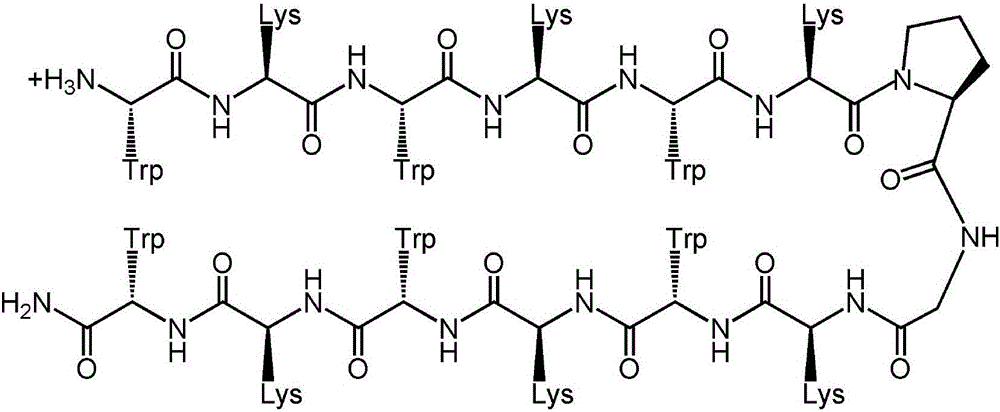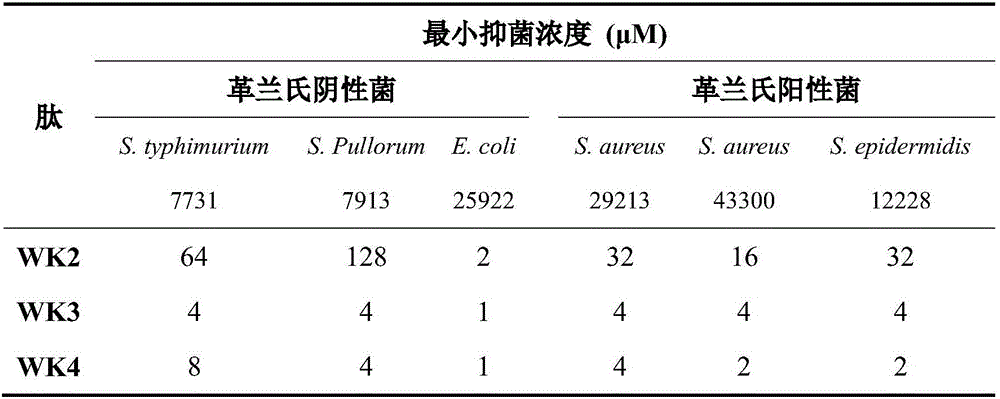Tryptophan tension chain-beta-hairpin antibacterial peptide and preparation method and application thereof
A tryptophan zipper and antibacterial peptide technology, applied in the biological field, can solve the problems of increasing synthesis difficulty, production cost, loss, biological activity decline, etc.
- Summary
- Abstract
- Description
- Claims
- Application Information
AI Technical Summary
Problems solved by technology
Method used
Image
Examples
Embodiment 1
[0015] Molecular Design of Antimicrobial Peptides
[0016] according to figure 1 The molecular structure of the water-transporting tryptophan W is arranged in pairs on the non-hydrogen bond formation sites of the two arms of the hairpin to form a cross-chain W-W interaction to stabilize the β-hairpin structure. The positively charged tryptophan is selected Lysine K is arranged on the hydrogen bond formation site to make the antibacterial peptide cationic, so that the length of the two arms of the hairpin is extended in pairs with WK and KW as repeating units, and the WK series antimicrobial peptides are designed: (WK) n D PG(KW) n -NH 2 , n=2, 3, 4; when n=2, the antimicrobial peptide was named WK2; when n=3, the antimicrobial peptide was named WK3, and when n=4, the antimicrobial peptide was named WK4. Its amino acid sequence is shown in Table 1.
[0017] Table 1 Amino Acid Sequence of Derived Peptides
[0018]
[0019] The carboxyl termini of the three peptides WK2,...
Embodiment 2
[0021] Synthesis of Three Antimicrobial Peptides WK2, WK3 and WK4 by Solid Phase Chemical Synthesis
[0022] 1. The preparation of antimicrobial peptides is carried out one by one from the C-terminal to the N-terminal, and is completed by a peptide synthesizer. First, Fmoc-X (X is the first amino acid at the C-terminal of each antimicrobial peptide) is inserted into Wang resin, and then the Fmoc group is removed to obtain X-Wang resin; then Fmoc-Y-Trt-OH (9 -Fmoxy-trimethyl-Y, Y is the second amino acid at the C-terminus of each antimicrobial peptide); according to this procedure, it is synthesized from the C-terminus to the N-terminus until the synthesis is completed, and the side of the Fmoc group is removed chain protection resin;
[0023] 2. Add a cleavage reagent to the peptide resin obtained above, react for 2 hours at 20°C in the dark, filter; wash the precipitate with TFA (trifluoroacetic acid), mix the washing liquid with the above filtrate, concentrate with a rotary...
Embodiment 3
[0027] Determination of antimicrobial activity of antimicrobial peptides
[0028] 1. Determination of antibacterial activity: Prepare the peptide as a storage solution for use. The minimum inhibitory concentrations of several antimicrobial peptides were determined by the broth microdilution method. Using 0.01% acetic acid (containing 0.2% BSA) as the diluent, a series of gradient antimicrobial peptide solutions were sequentially prepared using the double dilution method. Take 100 μL of the above solution and place it in a 96-well cell culture plate, then add an equal volume of the bacteria solution to be tested (~10 5 individual / mL) in each well. Positive controls (containing bacterial fluid but not antimicrobial peptides) and negative controls (neither bacterial fluid nor peptides) were set up. Incubate at a constant temperature of 37°C for 20 hours, and the minimum inhibitory concentration is the one where no turbidity is seen at the bottom of the well with the naked eye....
PUM
 Login to View More
Login to View More Abstract
Description
Claims
Application Information
 Login to View More
Login to View More - R&D
- Intellectual Property
- Life Sciences
- Materials
- Tech Scout
- Unparalleled Data Quality
- Higher Quality Content
- 60% Fewer Hallucinations
Browse by: Latest US Patents, China's latest patents, Technical Efficacy Thesaurus, Application Domain, Technology Topic, Popular Technical Reports.
© 2025 PatSnap. All rights reserved.Legal|Privacy policy|Modern Slavery Act Transparency Statement|Sitemap|About US| Contact US: help@patsnap.com



